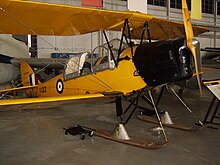
Back British Commonwealth Air Training Plan German Plan de Formación Aérea de la Comunidad Británica Spanish Plan d'entraînement aérien du Commonwealth britannique French תוכנית אימוני האוויר של חבר העמים הבריטי HE Plano de Treino Aéreo da Comunidade Britânica Portuguese
| British Commonwealth Air Training Plan | |
|---|---|
| Part of the Second World War | |
| Australia, Canada, New Zealand, United States | |
 | |
| Site history | |
| In use | 1939–45 |

The British Commonwealth Air Training Plan (BCATP), often referred to as simply "The Plan", was a large-scale multinational military aircrew training program created by the United Kingdom, Canada, Australia and New Zealand during the Second World War.[1] The BCATP remains one of the single largest aviation training programs in history and was responsible for training nearly half the pilots, navigators, bomb aimers, air gunners, wireless operators and flight engineers who served with the Royal Air Force (RAF), Royal Navy Fleet Air Arm (FAA), Royal Australian Air Force (RAAF), Royal Canadian Air Force (RCAF) and Royal New Zealand Air Force (RNZAF) during the war.[2]
Trainees from many other countries attended schools under the Plan, including Argentina, Belgium, Ceylon, Czechoslovakia, Denmark, Finland, Fiji, Free France, Greece, the Netherlands, Newfoundland, Norway, Poland,[3] and the United States.[4]
Canada was chosen as the primary location for the BCATP's training operations.[5]
- ^ Hayter, Steven. "History of the Creation of the British Commonwealth Air Training Plan." Archived 29 October 2010 at the Wayback Machine British Commonwealth Air Training Plan Museum, Retrieved: 18 October 2010.
- ^ Dunmore 1994, pp. 45, 345.
- ^ "British Commonwealth Air Training Plan". Juno Beach Centre. 31 March 2014.
- ^ Barris 2005, p. 316.
- ^ Hallowell 2004, p. 88.